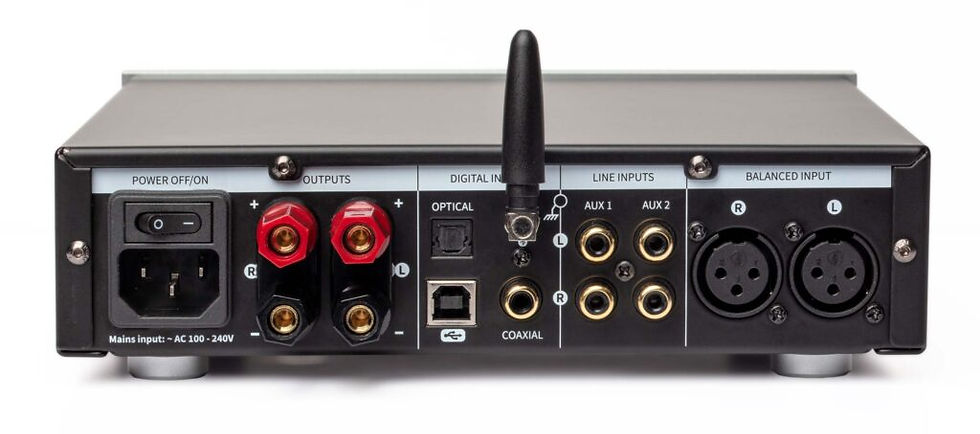FinkTeam Borg Episode 2
A SPEAKER FOR YEARS TO COME
Introduced very successfully at the Munic High End 2023, the FinkTeam Borg Episode 2 masters the excellent performance already shown with the original Borg.
FinkTeam’s Borg Episode 2 is two-way floor standing design featuring a 10.25 inch high-power mid/ bass driver and an Air Motion Transformer (AMT) tweeter.
Borg is a significant design exercise in its own right, as knitting a 10.25 inch mid/bass, albeit an extremely fine one, with a HF unit is never easy. To combine the two drivers to achieve a flat frequency response and, more importantly, a slow even mid/HF roll off in the power response is a significant feat of engineering. There is no off-axis hole in the middle effect.
For those of you who don’t know FinkTeam, it is ‘what it says in the name’. A team of talented German experts in their respective fields who decided, with Karl-Heinz Fink as their head, to create a brand and to design products that they wished to own.
Their day jobs, in general, are as specialists working for Fink Audio Consulting, Europe’s leading acoustical consultancy.
PRODUCT DESCRIPTION
MID/BASS UNIT
As one would expect the mid-bass driver of Borg is custom designed and manufactured exactly for the purpose. 10.25 inch mid/bass units are relatively unusual and crossing them well to HF units is not trivial but FinkTeam is relatively unusual: a technical challenge is just a design exercise that may take a little longer to solve. The benefits of a 10.25 inch mid/bass once heard are difficult to forget. A level of dynamics and naturalness around voices that is unusual and a richness to the sound without bloom or boom (in a well-designed system) that just sounds right. Smaller 2-way systems sound anaemic after hearing a 10 inch.
The Borg’s mid/bass unit features similar thinking to the WM-4’s bass driver: low hysteresis surround (it too looks like a pro driver), a large 3 inch voice coil for better control and power handling and a light stiff paper cone.
Of course, it includes all the normal FinkTeam design essentials: an alu- minium shorting ring on the centre pole to reduce voice coil inductance change with position and to reduce flux variation as a function of voice coil current.
The die-cast aluminium chassis is fully vented for low air speed, as is the voice coil former, both reducing distortion and compression.
All this brings a dynamic low-coloration drive unit with high power hand- ling and very low thermal compression.
HF UNIT
The tweeter is an Air Motion Transformer (AMT) operating according to the principles established by its inventor Oskar Heil.
Developed by Mundorf together with FinkTeam and manufactured specifically for FinkTeam by Mundorf, the AMT has a strong 25um-thick pleated Kapton diaphragm with 50um aluminium strips.
This material has extremely good internal damping, resulting in particu- larly low distortion. A special etching process was developed to produce it and the diaphragm configuration optimized through a large number of tests.
Given the 10.25 inch mid/bass unit and a lower than average crossover frequency of 1600Hz, a larger AMT driver with a 6464 mm2 surface area was ideal. Frequency response easily reaches up to 30kHz while distor- tion is very low and mainly second harmonic. The AMTs almost constant impedance also facilitates simplified crossover design.
CROSSOVER
As can be seen from the power response curve, the drive to the room is totally even, reducing slowly with frequency. Comparing this with a classic modern 2-way which shows some of the uneven room drive. The crossover is 4th order acoustic Linkwitz-Riley with a time delay addition between LF and HF.
At the same time the impedance of Borg has not been compromised to gain false sensitivity. At 87dB at 1m for 2.83V and with relatively gentle phase angles, it is an easy load for an amplifier.
CABINET
Typical loudspeaker cabinets have pronounced structural resonances which are very audible and reduce the speaker’s ‘signal-to-noise ratio’. At FinkTeam we take this aspect of loudspeaker performance very seriously because we know that a quiet cabinet allows the reproduction of low-level detail in a recording which is otherwise swamped by spurious cabinet output. Coloration and time smear are reduced, stereo image focus is improved, and listener fatigue avoided.
The design emphasis is on panel damping. It is impossible to force all the panel bending resonances above the passband so instead they are damped to reduce their amplitude to below audibility. This is achieved using a multilayer construction that combines multi-thickness MDF panels with a damping layer whose internal friction converts vibration into heat. FinkTeam developed algorithms help specify ideal material thicknesses to achieve the best results, but the ultimate determination is made by subjective assessment.
Enthusiasts spend thousands buying quieter equipment – products that seem to generate (or not in fact) more space between notes to ultima- tely have the effect considerably reduced by noisy loudspeaker cabinets. FinkTeam’s COMSOL modelling and Laser Scanning allow prediction and measurement of the results of cabinet designs.
An example of this was the cabinet opening to mount the 10.25 inch mid/bass driver. Even with the drivers rigidly mounted there was some unwanted vibration. Almost invisible to the touch test it was obvious under the laser scanner. A solid metal ring behind the driver mounting solved the problem and hence increased the signal to noise ratio.
DISTORTION
Besides linearity and signal-to-noise the other key parameter the FinkTeam fight for is low distortion.
Low distortion just makes it easier to listen for longer and for instruments to sound more natural. Compare brass instruments live to that reproduced by the average hi-fi system and to a system with low distortion and it’s clear that low distortion is far more natural.
top of page

luxury audio distribution
$36,490.00Price
Related Products
bottom of page































